A Piezoelectric Wave Energy Harvester Using Plucking-Driven and Frequency Up-Conversion Mechanism
Abstract
:1. Introduction
2. Conceptual Design
3. Design, Analysis, Fabrication, and Testing of PDPWEH
3.1. The Output Electromechanical Model of the Piezoelectric Composite Beam
3.2. Analysis of Electromechanical Dynamics with Geometrical Parameters
3.3. The Fabrication of the Piezoelectric Composite Beams
3.4. Experimental Setup
4. Results and Discussion
4.1. Characterization of the PZT Film
4.2. The Dynamic Characteristics of the PDPWEH
4.3. Electrical Performance of the PDPWEH
5. Conclusions
Author Contributions
Funding
Institutional Review Board Statement
Informed Consent Statement
Data Availability Statement
Acknowledgments
Conflicts of Interest
References
- Khan, N.; Kalair, A.; Abas, N.; Haider, A. Review of ocean tidal, wave and thermal energy technologies. Renew. Sustain. Energy Rev. 2017, 72, 590–604. [Google Scholar] [CrossRef]
- Drew, B.; Plummer, A.R.; Sahinkaya, M.N. A review of wave energy converter technology. Proc. Inst. Mech. Eng. Part A J. Power Energy 2016, 223, 887–902. [Google Scholar] [CrossRef] [Green Version]
- Farrok, O.; Ahmed, K.; Tahlil, A.D.; Farah, M.M.; Kiran, M.R.; Islam, M.R. Electrical Power Generation from the Oceanic Wave for Sustainable Advancement in Renewable Energy Technologies. Sustainability 2020, 12, 2178. [Google Scholar] [CrossRef] [Green Version]
- Rahman, A.; Farrok, O.; Islam, M.R.; Xu, W. Recent Progress in Electrical Generators for Oceanic Wave Energy Conversion. IEEE Access 2020, 8, 138595–138615. [Google Scholar] [CrossRef]
- Huang, L.; Hu, M.; Yu, H.; Liu, C.; Chen, Z. Design and experiment of a direct-drive wave energy converter using outer-PM linear tubular generator. IET Renew. Power Gener. 2017, 11, 353–360. [Google Scholar] [CrossRef]
- Trapanese, M.; Curto, D.; Franzitta, V.; Liu, Z.; McNabb, L.; Wang, X. A Planar Generator for a Wave Energy Converter. IEEE Trans. Magn. 2019, 55, 1–7. [Google Scholar] [CrossRef] [Green Version]
- Mutsuda, H.; Tanaka, Y.; Patel, R.; Doi, Y.; Moriyama, Y.; Umino, Y. A painting type of flexible piezoelectric device for ocean energy harvesting. Appl. Ocean Res. 2017, 68, 182–193. [Google Scholar] [CrossRef]
- Yang, Z.; Zhou, S.; Zu, J.; Inman, D. High-Performance Piezoelectric Energy Harvesters and Their Applications. Joule 2018, 2, 642–697. [Google Scholar] [CrossRef] [Green Version]
- Elahi, H.; Eugeni, M.; Gaudenzi, P. A Review on Mechanisms for Piezoelectric-Based Energy Harvesters. Energies 2018, 11, 1850. [Google Scholar] [CrossRef] [Green Version]
- Tian, W.; Ling, Z.; Yu, W.; Shi, J. A Review of MEMS Scale Piezoelectric Energy Harvester. Appl. Sci. 2018, 8, 645. [Google Scholar] [CrossRef] [Green Version]
- Ali, F.; Raza, W.; Li, X.; Gul, H.; Kim, K.-H. Piezoelectric energy harvesters for biomedical applications. Nano Energy 2019, 57, 879–902. [Google Scholar] [CrossRef]
- Kiran, M.R.; Farrok, O.; Mamun, A.A.; Islam, R.; Xu, W. Progress in Piezoelectric Material Based Oceanic Wave Energy Conversion Technology. IEEE Access 2020, 8, 146428–146449. [Google Scholar] [CrossRef]
- Nabavi, S.F.; Farshidianfar, A.; Afsharfard, A.; Khodaparast, H.H. An ocean wave-based piezoelectric energy harvesting system using breaking wave force. Int. J. Mech. Sci. 2018, 151, 498–507. [Google Scholar] [CrossRef] [Green Version]
- Taylor, G.; Burns, J.; Kammann, S.; Powers, W.; Welsh, T. The Energy Harvesting Eel: A small subsurface ocean/river power generator. IEEE J. Ocean. Eng. 2001, 26, 539–547. [Google Scholar] [CrossRef] [Green Version]
- Xie, X.; Wang, Q.; Wu, N. Energy harvesting from transverse ocean waves by a piezoelectric plate. Int. J. Eng. Sci. 2014, 81, 41–48. [Google Scholar] [CrossRef]
- Viñolo, C.; Toma, D.; Mànuel, A.; del Rio, J. An ocean kinetic energy converter for low-power applications using piezoelectric disk elements. Eur. Phys. J. Spec. Top. 2013, 222, 1685–1698. [Google Scholar] [CrossRef]
- Nabavi, S.F.; Farshidianfar, A.; Afsharfard, A. Novel piezoelectric-based ocean wave energy harvesting from offshore buoys. Appl. Ocean Res. 2018, 76, 174–183. [Google Scholar] [CrossRef]
- Xie, X.; Wang, Q. A study on an ocean wave energy harvester made of a composite piezoelectric buoy structure. Compos. Struct. 2017, 178, 447–454. [Google Scholar] [CrossRef]
- Renzi, E. Hydroelectromechanical modelling of a piezoelectric wave energy converter. Proc. R. Soc. A Math. Phys. Eng. Sci. 2016, 472, 20160715. [Google Scholar] [CrossRef] [Green Version]
- Patel, R.; Tanaka, Y.; McWilliam, S.; Mutsuda, H.; Popov, A. Model refinements and experimental testing of highly flexible piezoelectric energy harvesters. J. Sound Vib. 2016, 368, 87–102. [Google Scholar] [CrossRef]
- Mutsuda, H.; Tanaka, Y.; Patel, R.; Doi, Y. Harvesting flow-induced vibration using a highly flexible piezoelectric energy device. Appl. Ocean Res. 2017, 68, 39–52. [Google Scholar] [CrossRef]
- Viet, N.; Xie, X.; Liew, K.M.; Banthia, N.; Wang, Q. Energy harvesting from ocean waves by a floating energy harvester. Energy 2016, 112, 1219–1226. [Google Scholar] [CrossRef]
- Lin, Z.; Zhang, Y. Dynamics of a mechanical frequency up-converted device for wave energy harvesting. J. Sound Vib. 2016, 367, 170–184. [Google Scholar] [CrossRef]
- Pozzi, M.; Zhu, M. Plucked piezoelectric bimorphs for knee-joint energy harvesting: Modelling and experimental validation. Smart Mater. Struct. 2011, 20, 055007. [Google Scholar] [CrossRef] [Green Version]
- Fu, X.; Liao, W.-H. Modeling and Analysis of Piezoelectric Energy Harvesting With Dynamic Plucking Mechanism. J. Vib. Acoust. 2019, 141, 031002. [Google Scholar] [CrossRef]
- Fang, S.; Fu, X.; Du, X.; Liao, W.-H. A music-box-like extended rotational plucking energy harvester with multiple piezoelectric cantilevers. Appl. Phys. Lett. 2019, 114, 233902. [Google Scholar] [CrossRef]
- Priya, S. Modeling of electric energy harvesting using piezoelectric windmill. Appl. Phys. Lett. 2005, 87, 184101. [Google Scholar] [CrossRef]
- Erturk, A.; Inman, D.J. A Distributed Parameter Electromechanical Model for Cantilevered Piezoelectric Energy Harvesters. J. Vib. Acoust. 2008, 130, 041002. [Google Scholar] [CrossRef]
- Chen, S.-E.; Yang, R.-Y.; Wu, G.-K.; Wu, C.-C. A Piezoelectric Wave-Energy Converter Equipped with a Geared-Linkage-Based Frequency Up-Conversion Mechanism. Sensors 2020, 21, 204. [Google Scholar] [CrossRef]
- Erturk, A.; Inman, D.J. On Mechanical Modeling of Cantilevered Piezoelectric Vibration Energy Harvesters. J. Intell. Mater. Syst. Struct. 2008, 19, 1311–1325. [Google Scholar] [CrossRef]
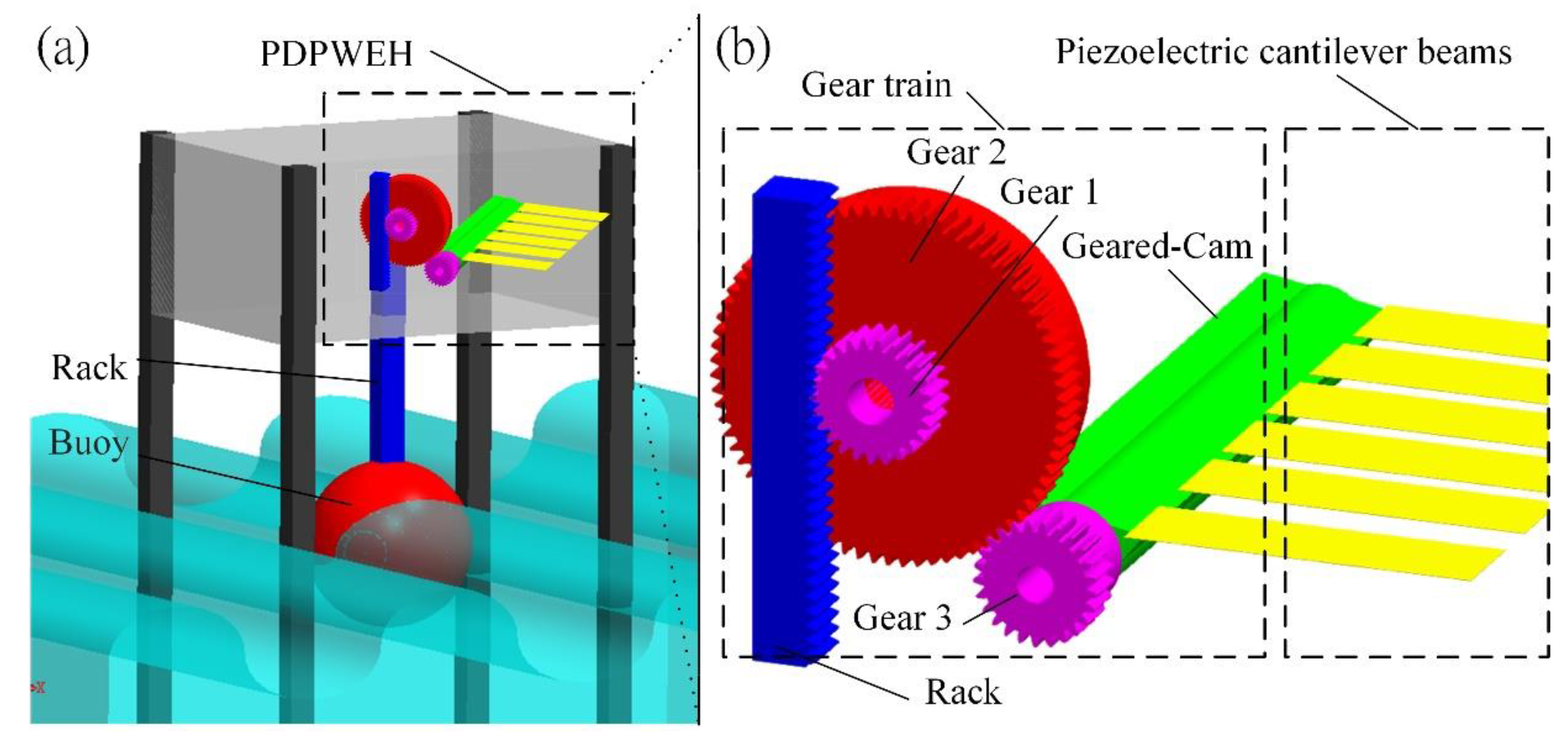

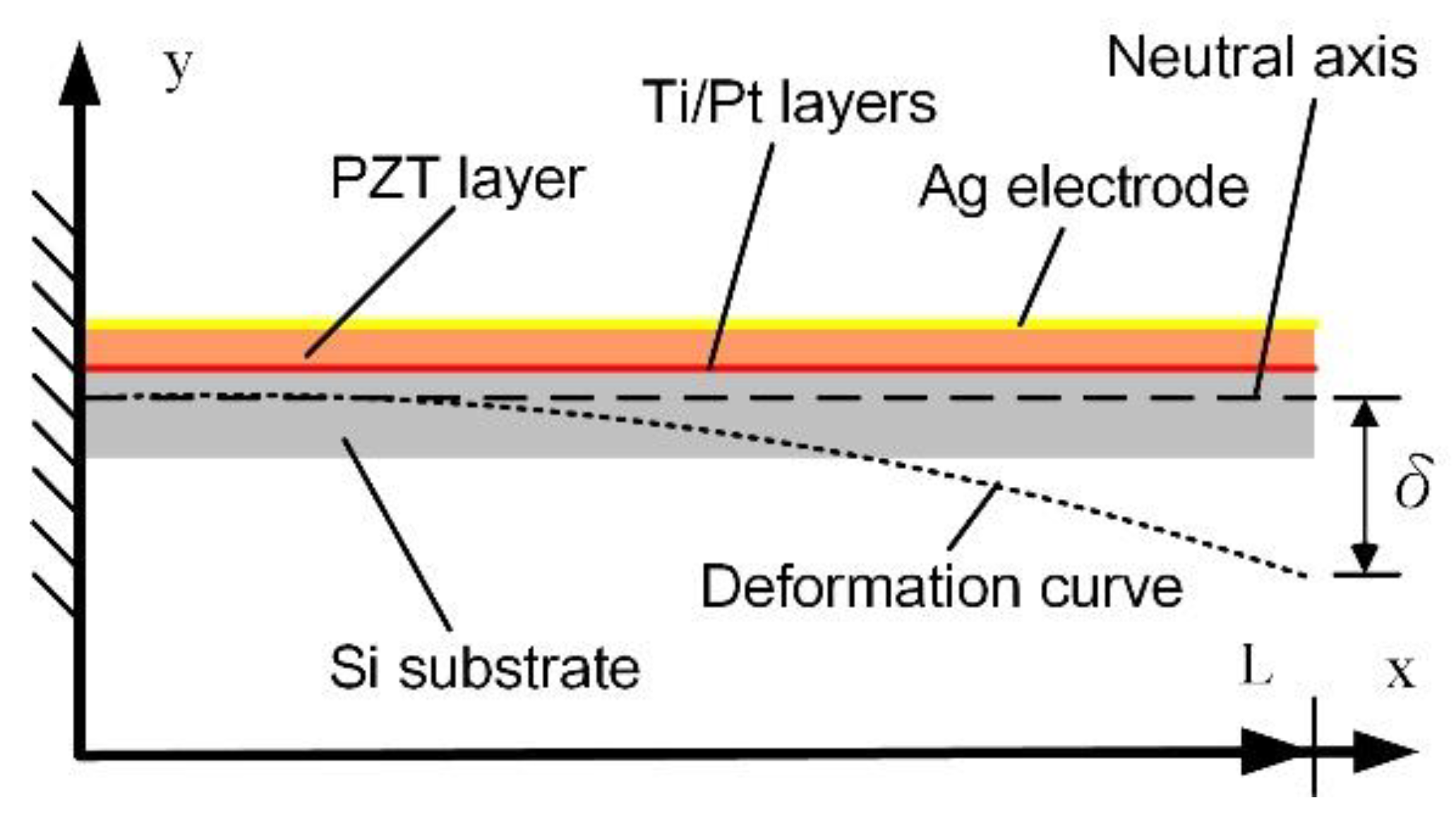
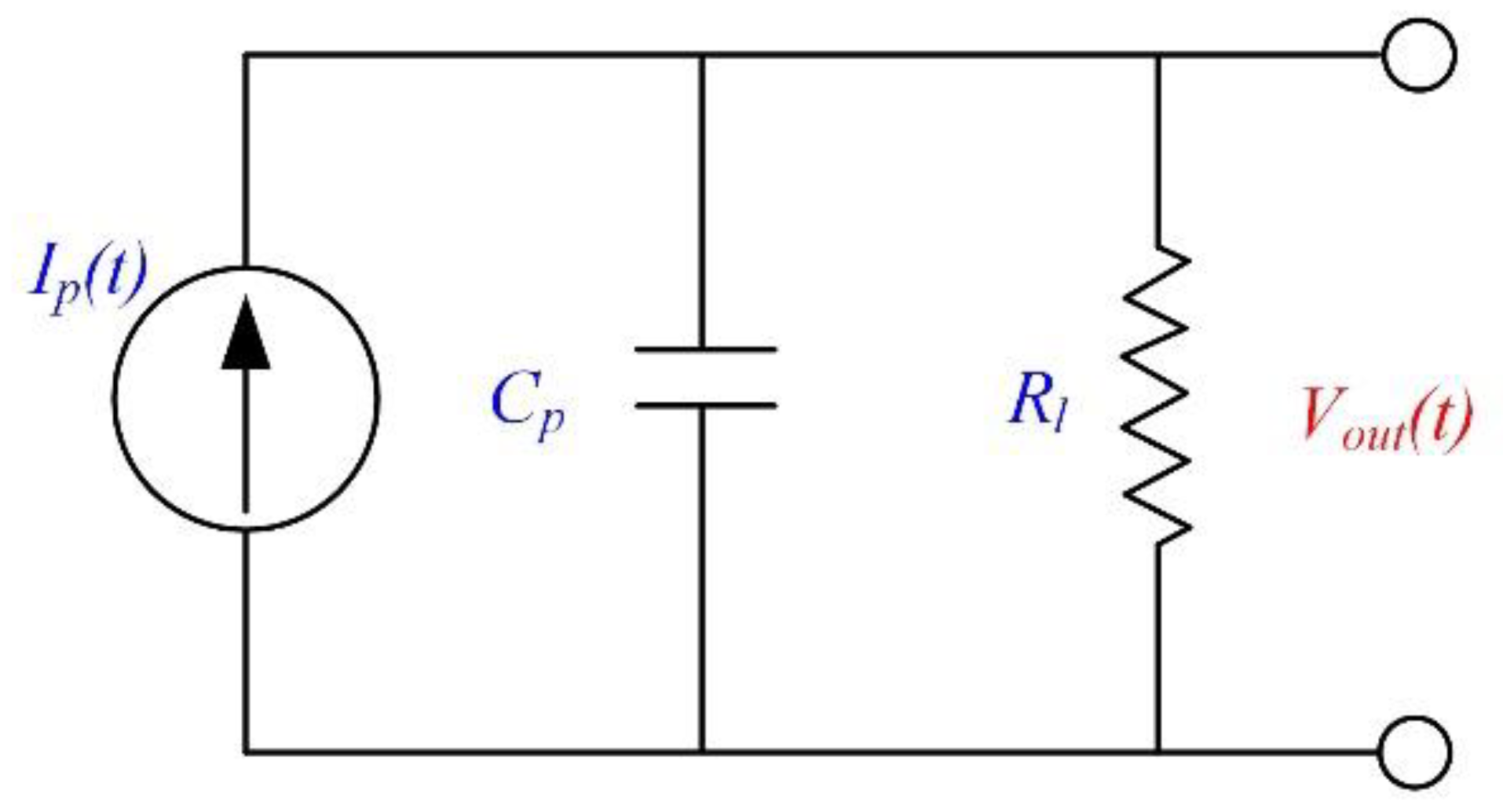
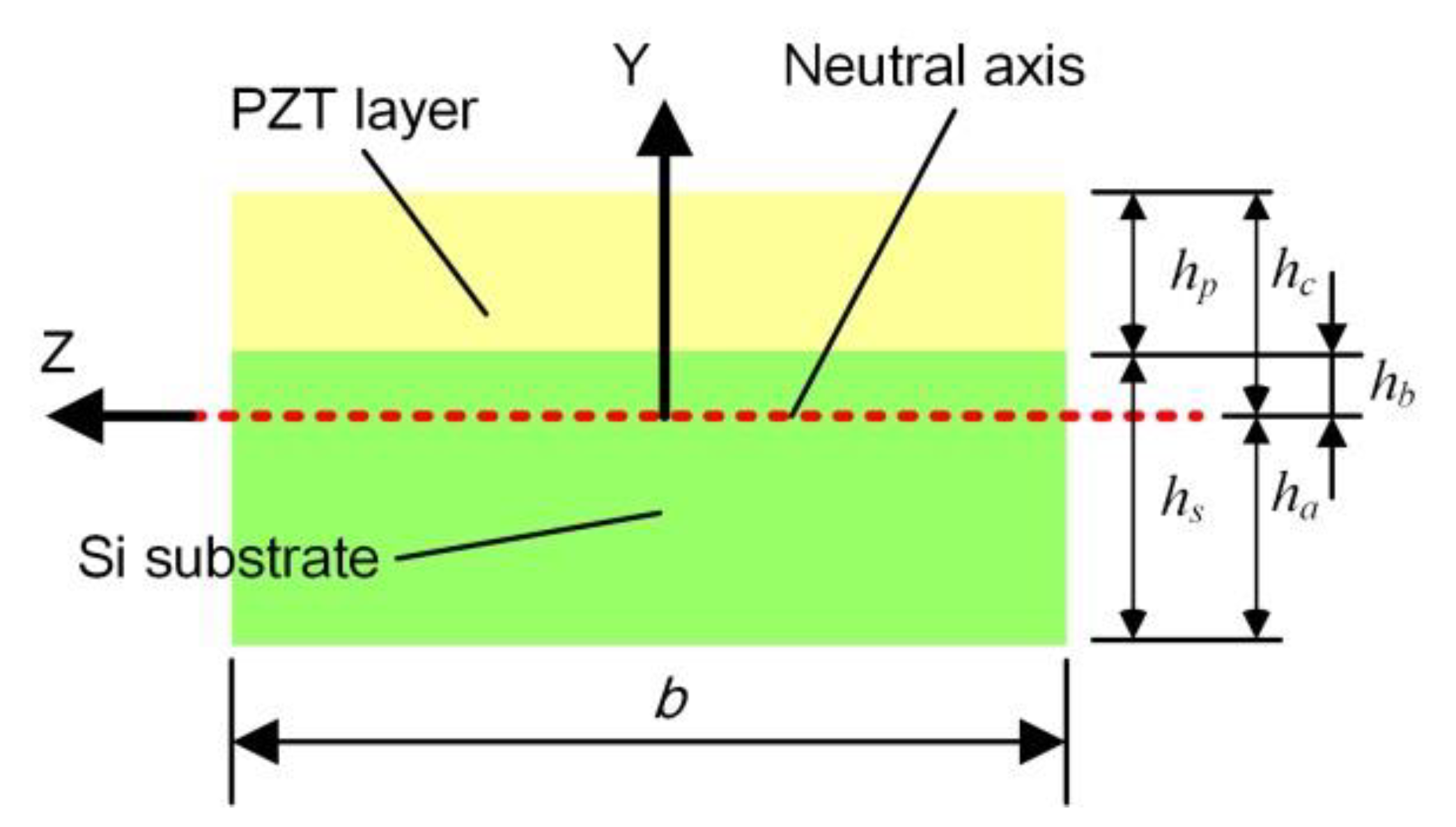

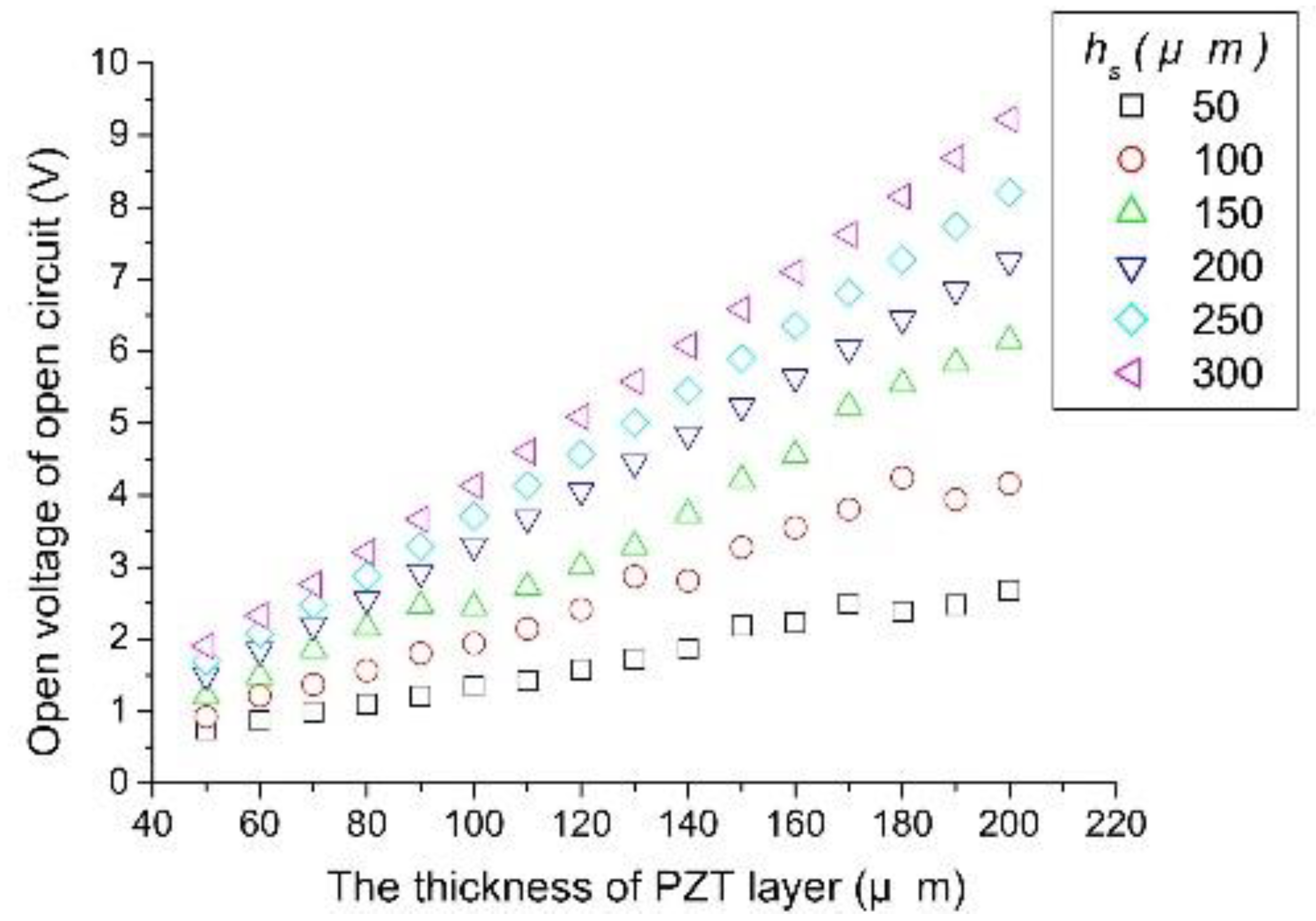
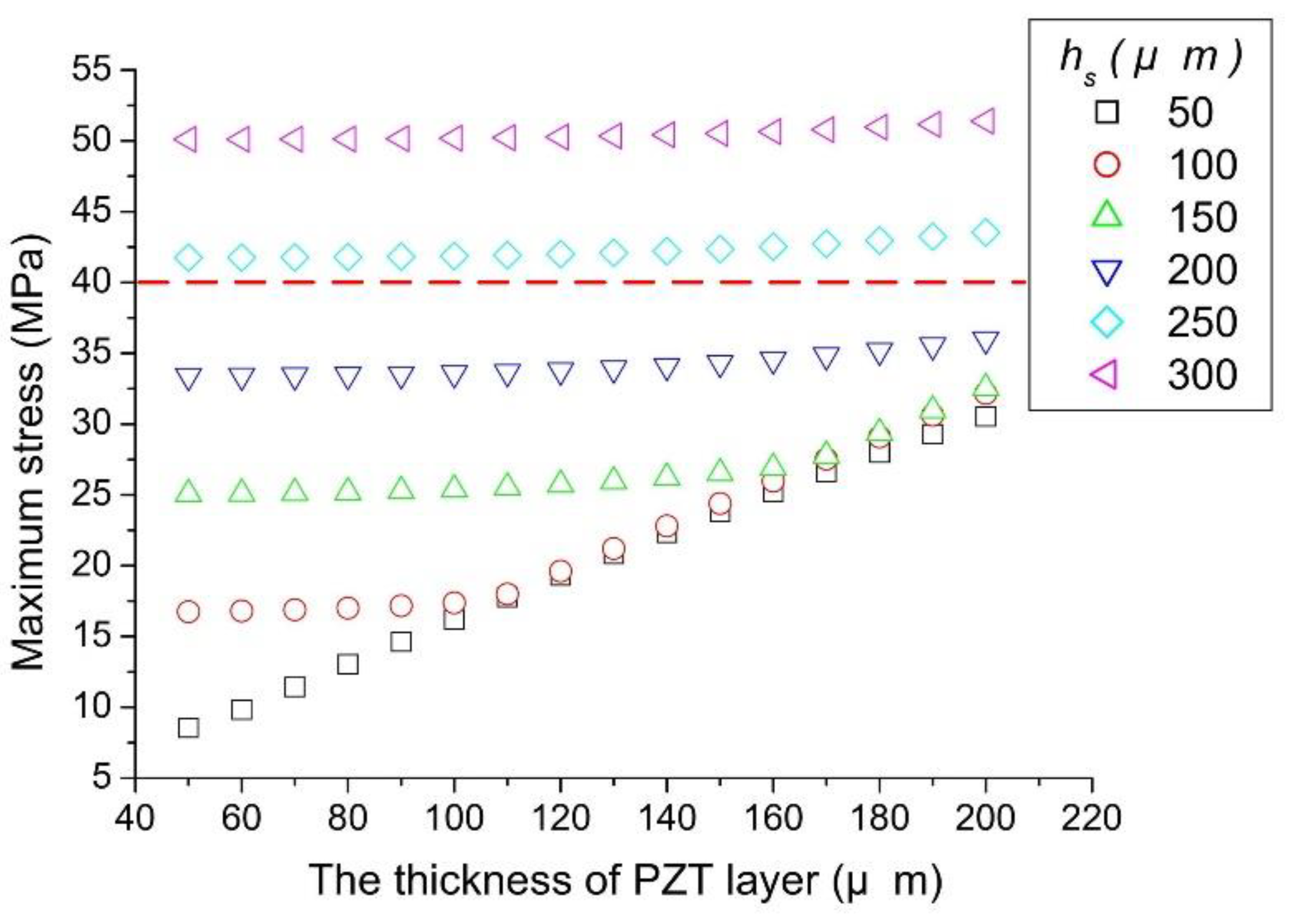
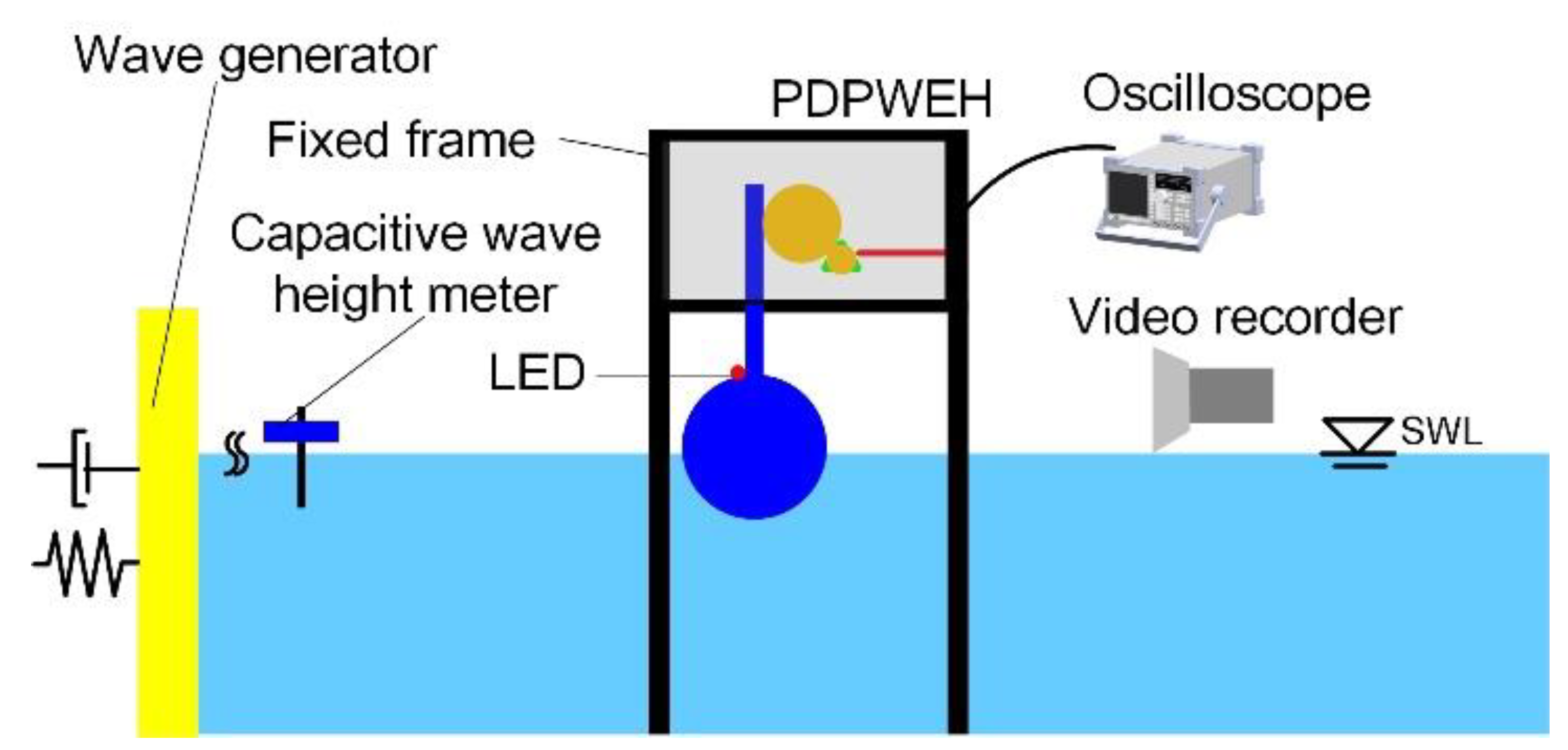
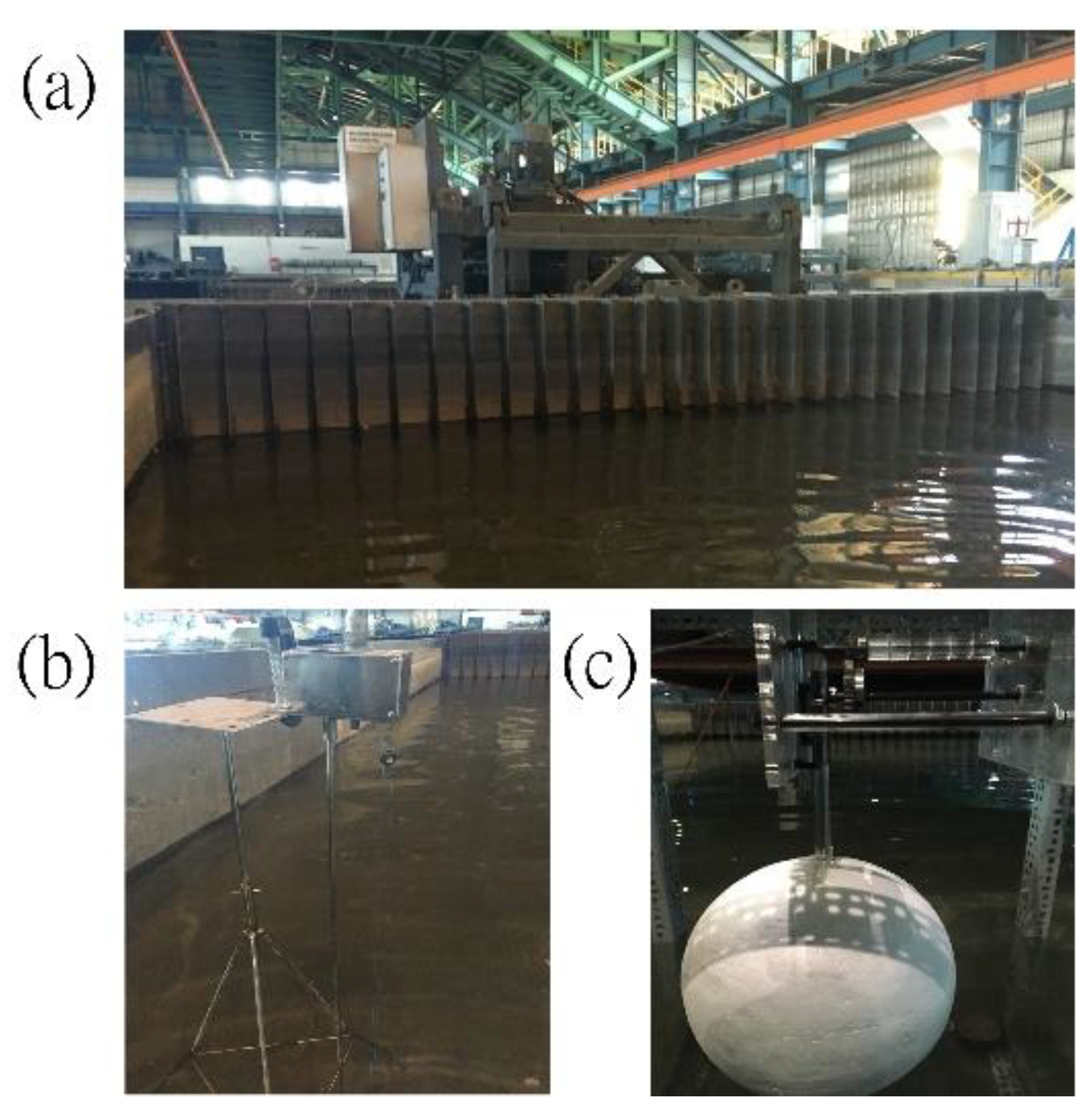
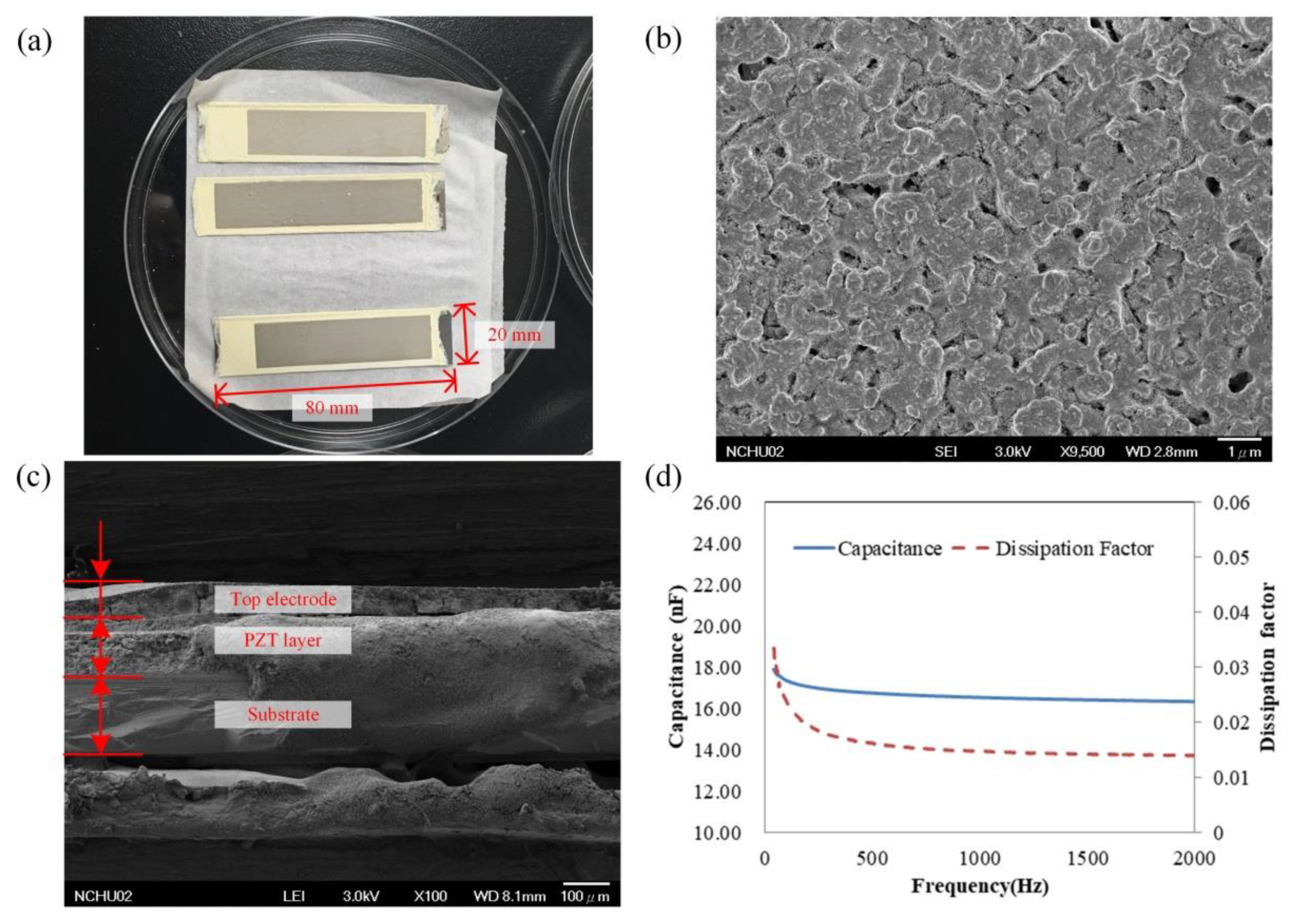
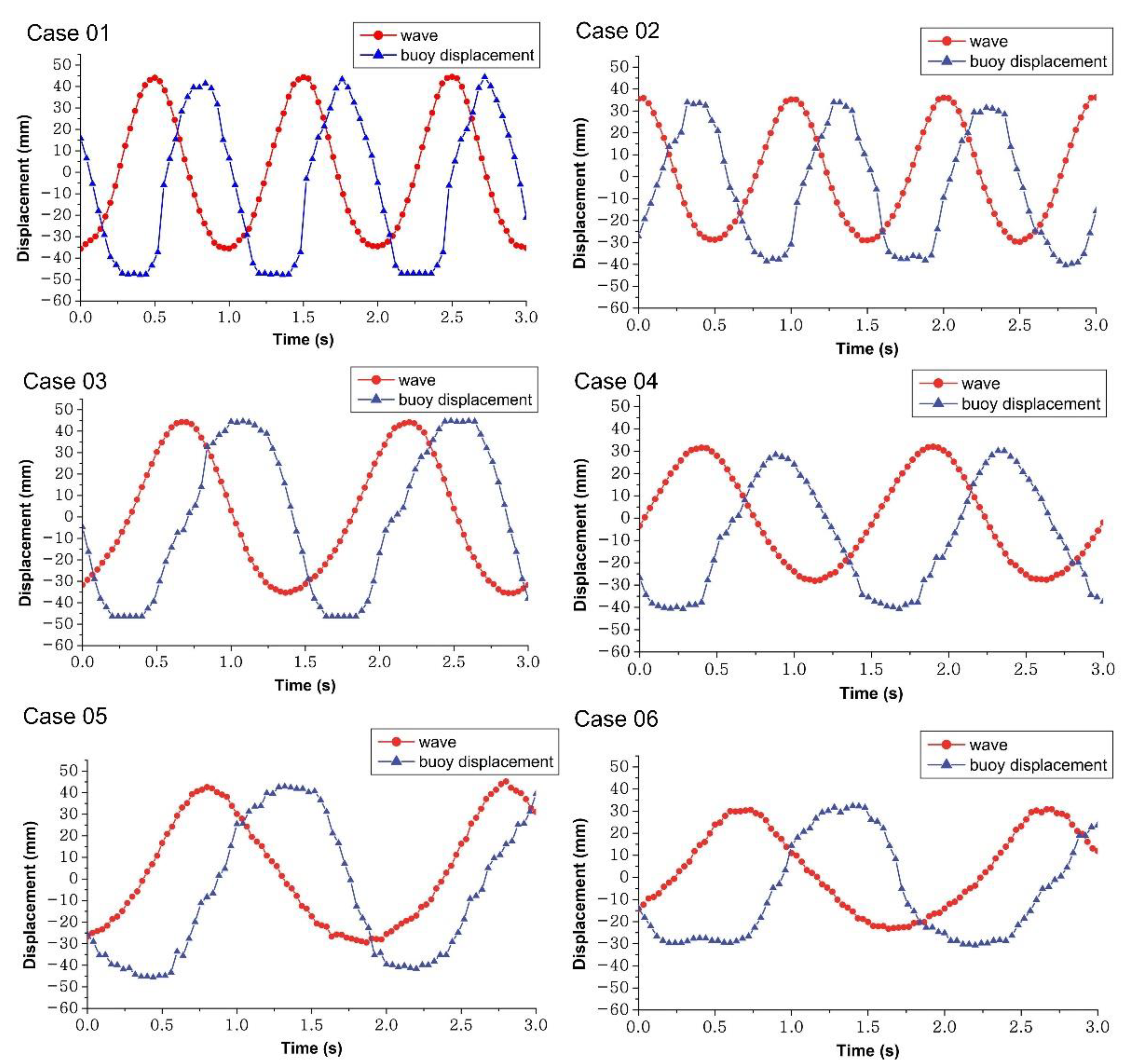
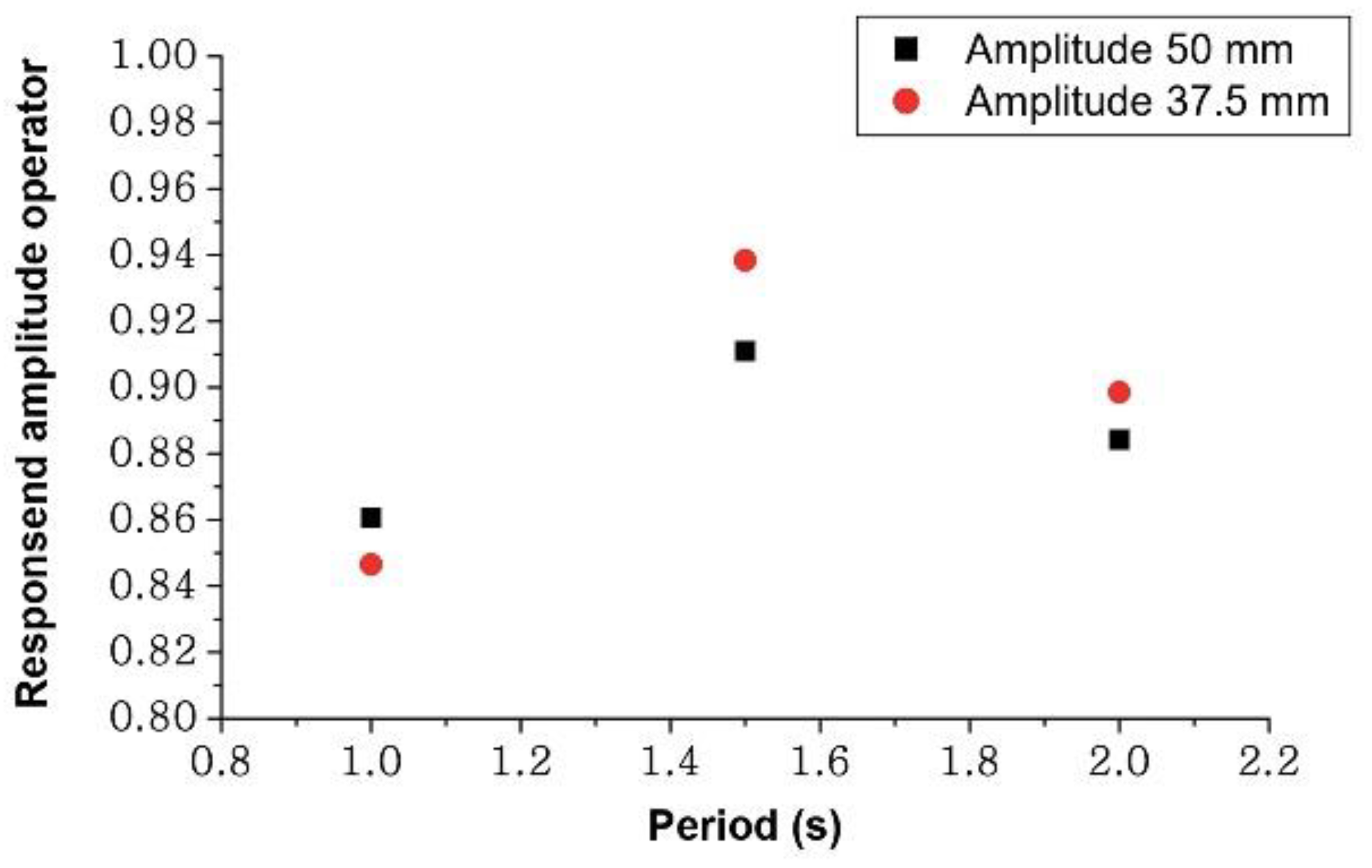
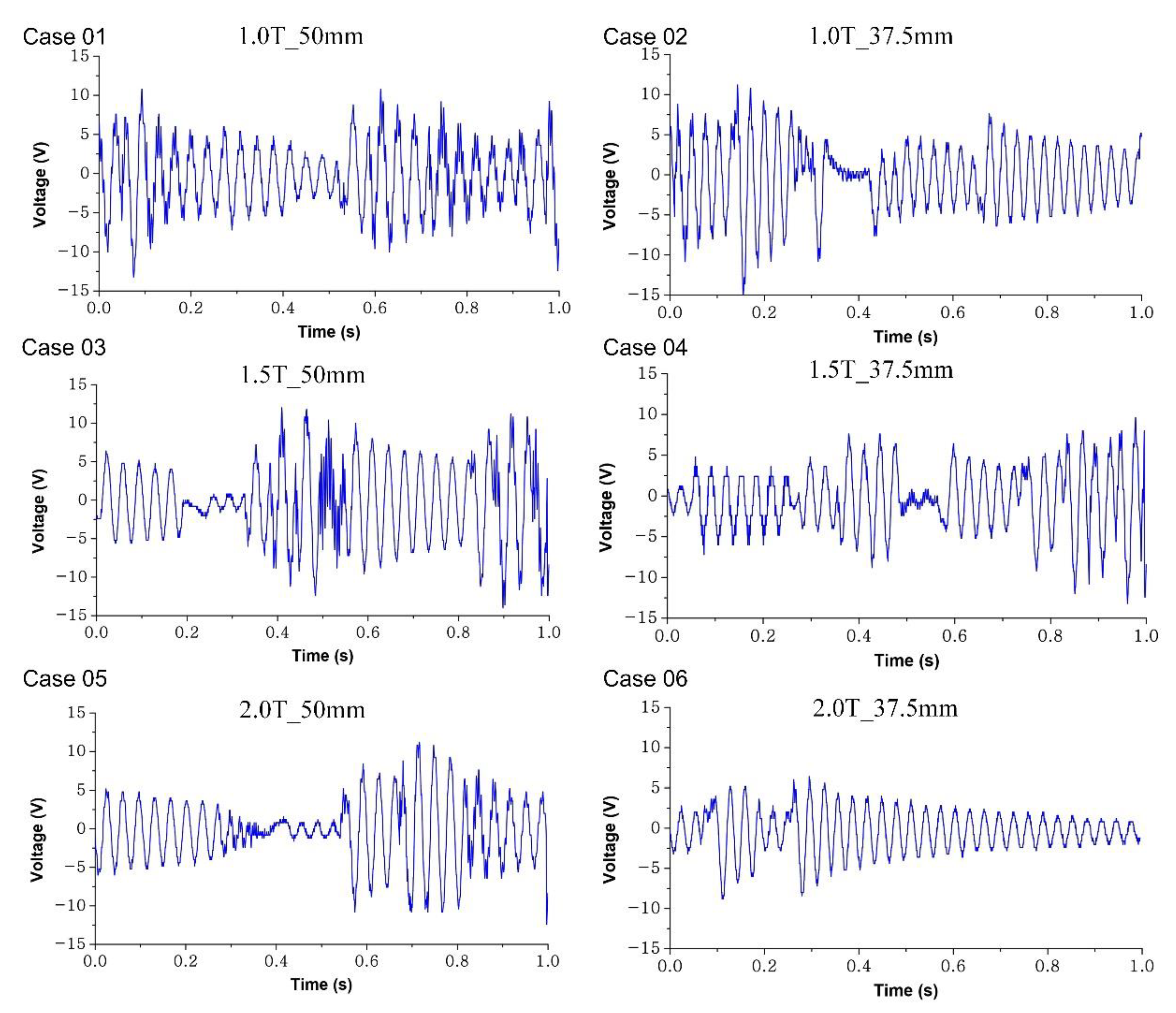
| Design Parameter | Symbol | Value (Unit) |
|---|---|---|
| The density of PZT layer | ρp | 7800 kg/m3 |
| The Young’s module of PZT layer | Yp | 67 GPa |
| The piezoelectric constant | d31 | −30 × 10−12 m/V |
| The permittivity constant at 1 kHz | ε | 1.53 × 10−8 |
| The density of silicon substrate | ρs | 2300 kg/m3 |
| The Young’s module of PZT layer | Ys | 179 GPa |
| Wave Height (mm) | 100 | 75 |
|---|---|---|
| Period (1 sec) | Case 01 | Case 02 |
| Period (1.5 sec) | Case 03 | Case 04 |
| Period (2.0 sec) | Case 05 | Case 06 |
| Case 01 | Case 02 | Case 03 | Case 04 | Case 05 | Case 06 | |
|---|---|---|---|---|---|---|
| Maximum voltage of open circuit (V) | 12.4 | 11.2 | 11.8 | 9.6 | 10.5 | 8.4 |
| RMS voltage of open circuit (V) | 5.01 | 4.18 | 4.84 | 3.8 | 4.04 | 2.62 |
| Average power of open circuit (μw) | 125.5 | 87.4 | 117.1 | 72.2 | 81.6 | 34.3 |
| RMS voltage with FDR filter circuit (V) | 0.91 | 0.74 | 0.89 | 0.63 | 0.59 | 0.46 |
| Average power with FDR filter circuit (μw) | 4.14 | 2.75 | 3.96 | 1.97 | 1.76 | 1.07 |
Publisher’s Note: MDPI stays neutral with regard to jurisdictional claims in published maps and institutional affiliations. |
© 2021 by the authors. Licensee MDPI, Basel, Switzerland. This article is an open access article distributed under the terms and conditions of the Creative Commons Attribution (CC BY) license (https://creativecommons.org/licenses/by/4.0/).
Share and Cite
Chen, S.-E.; Yang, R.-Y.; Qiu, Z.-H.; Wu, C.-C. A Piezoelectric Wave Energy Harvester Using Plucking-Driven and Frequency Up-Conversion Mechanism. Energies 2021, 14, 8441. https://doi.org/10.3390/en14248441
Chen S-E, Yang R-Y, Qiu Z-H, Wu C-C. A Piezoelectric Wave Energy Harvester Using Plucking-Driven and Frequency Up-Conversion Mechanism. Energies. 2021; 14(24):8441. https://doi.org/10.3390/en14248441
Chicago/Turabian StyleChen, Shao-En, Ray-Yeng Yang, Zeng-Hui Qiu, and Chia-Che Wu. 2021. "A Piezoelectric Wave Energy Harvester Using Plucking-Driven and Frequency Up-Conversion Mechanism" Energies 14, no. 24: 8441. https://doi.org/10.3390/en14248441
APA StyleChen, S.-E., Yang, R.-Y., Qiu, Z.-H., & Wu, C.-C. (2021). A Piezoelectric Wave Energy Harvester Using Plucking-Driven and Frequency Up-Conversion Mechanism. Energies, 14(24), 8441. https://doi.org/10.3390/en14248441








